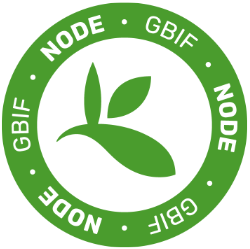News Articles
Published: 08-11-2021
Digitized paleontological collections recontextualize the ecology of introduced turkeys in California
Contributed by: Ashwin Sivakumar & Alexis Mychajliw
Managing invasive species is a central challenge in conservation biology. Quaternary fossil records and zooarchaeological assemblages are revealing that many of today’s introduced species may have more complicated...
Published: 08-10-2021
Contributed by: Molly Phillips
Boing! Photo: Allan Hack
Fox squirrels (Sciurus niger) are medium-sized tree squirrels with a long, full tail. They exhibit a variety of coat colors and patterns from pale grey to black though the most common color is reddish-brown (seen above). They are found in a diversity of deciduous and mixed-forest habitats and depend on trees for both food...
Published: 08-06-2021
iDigBio launched its new Digitization Academy this summer with an inaugural course, Introduction to Biodiversity Specimen Digitization. This free, online course focuses on introducing the creation of digital data about biodiversity specimens to those who are just beginning this activity. Instructors Michael Denslow, Erica Krimmel, and Austin Mast taught this course for the first time July 12-15,...
Published: 08-06-2021
iDigBio researchers and staff joined nearly 2000 other attendees from over 60 countries at the virtual Botany Conference, July 18-23, 2021. Talks throughout the conference showcased the essential role of herbaria–and digitized data associated with herbarium specimens–in the botanical sciences. In addition to contributing talks of their own, iDigBio researchers and staff collaborated...
Published: 07-19-2021
The Society for the Preservation of Natural History Collections (SPNHC) Education Committee hosted the first ever virtual Natural History Education DemoCamp. The goal of the NHE DemoCamp is to share, discover, and discuss educational materials that have a framework in natural history. This is building upon our previous iterations of the 'education share fair' that were hosted at...
Published: 07-14-2021
TDWG 2021, the annual conference of Biodiversity Information Standards, will be held virtually October 18-22, 2021, hosted by the University of Florida. The theme of this year’s conference, Connecting the world of biodiversity data: standards uniting people, processes, and tools, will build on lessons learned during the preceding 18 months of virtual interaction and...
Published: 07-08-2021
Assessment of the pinned specimen digitization progress of the University of Alaska Museum Insect Collection
Ashley L. Smith, Derek S. Sikes, Taylor L. Kane, Adam Haberski, Jayce B. Williamson, Renee K. Nowicki, Michael J. Apperson
University of Alaska Museum, University of Alaska Fairbanks, Fairbanks, Alaska, USA
This article was originally published in the Alaska...
Published: 07-02-2021
Written by Erica Krimmel.
This month let’s celebrate a friendly beetle that you’ve likely encountered, perhaps out on a hike or at home in your garden: the Soldier Beetle, i.e., a member of the family Cantharidae. These insects are globally distributed and their long antennae and striking colors–often red, orange, or yellow contrasting with black or brown–make them...
Published: 05-26-2021
"If their lives are short, they are merry," and "they still continue on singing till they die." - Benjamin Banneker
Photo by lalo_pangue on Flickr.
There has been plenty of buzz already about the 17-year cycle of the cicada happening this year, but few people know about Benjamin Banneker, a Black man born in 1731, who was one of the...
Published: 05-24-2021
Thoreau still contributes to climate change research
New study uses Henry David Thoreau’s observations of fruiting times
Digitized museum specimens, such this bluebead lily (Clintonia borealis), were used to determine the time of fruit ripening. © Consortium of Northeast Herbaria.
Researchers from Boston University (BU) combined Henry David Thoreau’s fruiting...




